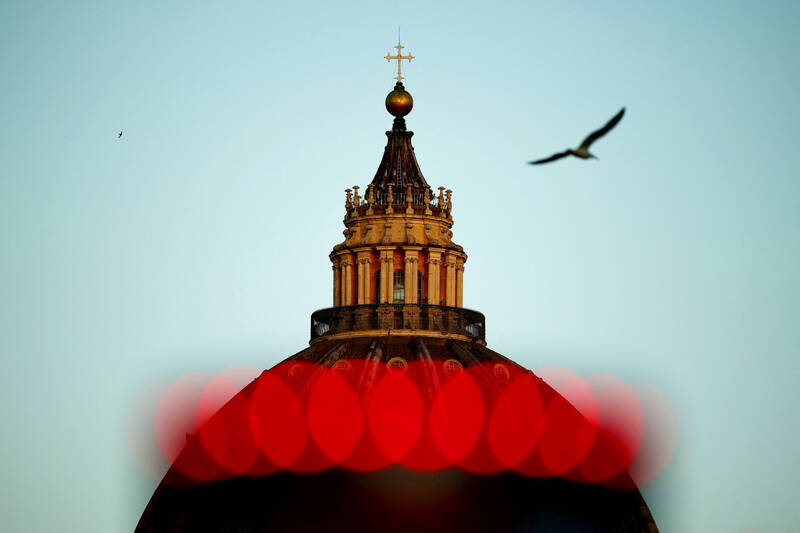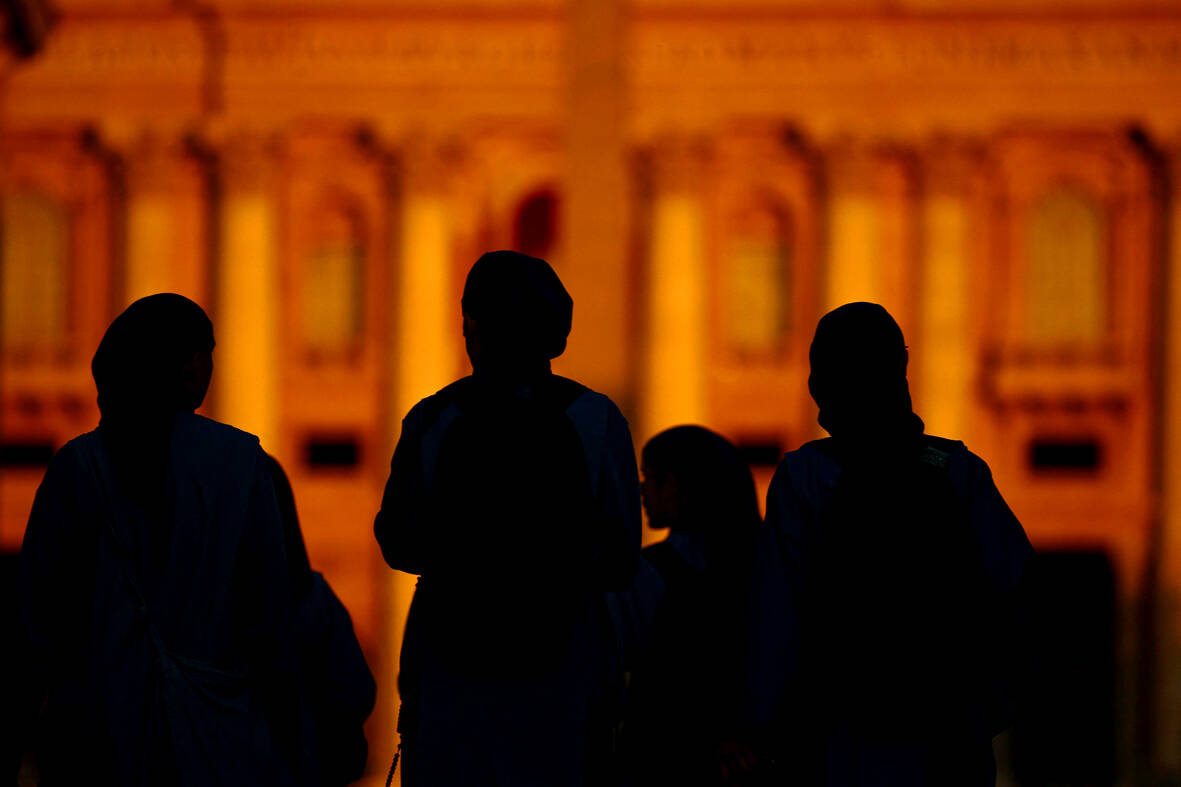One hundred and thirty-three cardinals are sequestering themselves behind the Vatican’s medieval walls for the start of a conclave yesterday to elect a successor to Pope Francis. Here are some things to know about the election of the 267th pontiff of the Catholic Church, which has 1.4 billion faithful across the world.
WHY NOW?
The conclave was called after Francis died on April 21 at age 88. There was a delay between his death and the conclave to allow time for a funeral, burial and a period of mourning. It was also necessary to give cardinals time to arrive in Rome from all corners of the Earth, and to let them get acquainted before entering the conclave, an ancient ritual steeped in mystery and ritual.

Photo: Reuters
WHAT HAPPENS IN THE CONCLAVE?
The cardinals are cut off from the world at the Vatican, between residences and the Sistine Chapel, where they vote in secret — and in silence — beneath Michelangelo’s famed ceiling fresco of the Creation and his monumental Last Judgment.
The process — fictionalized in the 2024 political thriller Conclave — is said to be guided by the Holy Spirit, and is designed to be both contemplative and free from outside interference.

Photo: Reuters
Taking no chances, the Vatican is asking cardinals to hand over their phones for the duration of the conclave and is deactivating cell phone coverage at the Vatican. It also plans to use signal jammers around the Sistine Chapel and the Domus Santa Marta hotel and adjacent residence where the cardinals will sleep, in order to prevent surveillance and communication with the outside world.
WHITE OR BLACK SMOKE SIGNALS?
The electors cast paper ballots, and voting continues until one candidate receives a two-thirds majority, or 89 votes. After two rounds of voting, ballots are burned in a special stove — black smoke signals no decision, while white smoke means a new pope has been chosen.
Electors must be under 80 years old, and are more geographically diverse than ever. They represent Catholicism’s growing presence in Africa, Asia and Latin America, as well as its traditional power base in Europe.
HOW LONG DOES IT TAKE?
The longest conclave in history lasted nearly three years, but it’s reasonable to assume that this conclave will be much, much shorter.
Cardinals this week said they expect a short conclave, though it will likely take at least a few rounds of voting. The conclave opened late afternoon yesterday, when cardinals were expected to hold the first round of voting, but there is no requirement that they do so.
For most of the past century, it has taken between three and eight ballots to find a pope. John Paul I — the pope who reigned for 33 days — was elected on the third ballot in 1978. His successor, St. John Paul II, needed eight. Francis was elected on the fifth in 2013.
WHO ARE THE CONTENDERS?
There are no official candidates for the papacy, but some cardinals are considered “papabile,” or possessing the characteristics necessary to become pope.
After John Paul II broke the Italian hold on the papacy in 1978, the field has broadened considerably, such that cardinals from far-flung countries are now seen as contenders. The past three popes have hailed from Poland (John Paul II), Germany (Benedict XVI) and Argentina (Francis).
Of the 133 cardinals expected to vote at the conclave, 108 were appointed by Francis. They may feel a loyalty to continuing his legacy — even though the late pontiff didn’t choose cardinals based on ideology, but rather for their pastoral priorities and geographical diversity.
Beyond that, the cardinals will consider practical matters, like age. Picking a relatively young man — say in his 60s — could result in a papacy of 20 years or longer.
Picking a pope from where the church is growing — Asia or Africa — could bring more upheaval to the Vatican’s Italian-heavy bureaucracy that is still smarting from the Argentine pope’s go-it-alone style.
WHAT HAPPENS WHEN NEW POPE IS CHOSEN?
Once a candidate receives the necessary votes and accepts, he chooses a papal name and enters the “Room of Tears” — named for the emotional weight of the responsibility ahead — to don his papal vestments.
Minutes later, he is introduced to the world from the balcony of St. Peter’s Basilica with the proclamation in Latin: Annuntio vobis gaudium magnum: Habemus Papam! (“I bring you tidings of great joy: We have a pope!”)
That will be immediately followed by the revelation of his baptismal name, in Latin, followed by the papal name he has chosen.
ANCIENT TRADITION
Every new pope is seen as a successor to St. Peter, the apostle believed by Catholics to have been appointed by Jesus as the head of the church. In the Gospel of Matthew, Jesus tells him,
“You are Peter, and on this rock I will build my church,” a verse that forms the biblical basis for the papacy.
According to tradition, Peter traveled to Rome to spread the Christian message and was martyred there during the reign of the Emperor Nero, around 64 AD, as Christians were being persecuted. He was said to be crucified upside down at his own request, considering himself unworthy to die in the same manner as Jesus.
St. Peter’s Basilica now stands over what is believed to be his tomb.
WHY DOES THE POPE MATTER?
Though the pope leads a religious institution, his influence extends far beyond it. Pope John Paul II played a pivotal role in supporting the Solidarity movement in his native Poland and encouraging resistance to Soviet domination in Eastern Europe. His moral leadership was credited by many with helping to hasten the end of the Cold War.
Pope Francis, the first pontiff from Latin America, became a prominent voice on global issues from climate change to migration and economic inequality. He called for compassion toward refugees, warned against the dangers of nationalism, and urged action to protect the planet — stances that resonated well beyond church walls, and at times put him at odds with political leaders.
WHAT’S IN A NAME?
The first sign of the new pope’s priorities will come in the name he chooses.
A Francis II might signal a new pope’s embrace of Francis’ legacy of prioritizing the poor and marginalized; a Pius would hint at a traditionalist restoration.
From John Paul to Benedict to Francis, each name has carried historical weight and theological intent. For the 267th pope, it will be his first message to the world.

Taiwan Power Co (Taipower, 台電) and the New Taipei City Government in May last year agreed to allow the activation of a spent fuel storage facility for the Jinshan Nuclear Power Plant in Shihmen District (石門). The deal ended eleven years of legal wrangling. According to the Taipower announcement, the city government engaged in repeated delays, failing to approve water and soil conservation plans. Taipower said at the time that plans for another dry storage facility for the Guosheng Nuclear Power Plant in New Taipei City’s Wanli District (萬里) remained stuck in legal limbo. Later that year an agreement was reached

What does the Taiwan People’s Party (TPP) in the Huang Kuo-chang (黃國昌) era stand for? What sets it apart from their allies, the Chinese Nationalist Party (KMT)? With some shifts in tone and emphasis, the KMT’s stances have not changed significantly since the late 2000s and the era of former president Ma Ying-jeou (馬英九). The Democratic Progressive Party’s (DPP) current platform formed in the mid-2010s under the guidance of Tsai Ing-wen (蔡英文), and current President William Lai (賴清德) campaigned on continuity. Though their ideological stances may be a bit stale, they have the advantage of being broadly understood by the voters.

In a high-rise office building in Taipei’s government district, the primary agency for maintaining links to Thailand’s 108 Yunnan villages — which are home to a population of around 200,000 descendants of the Chinese Nationalist Party (KMT) armies stranded in Thailand following the Chinese Civil War — is the Overseas Community Affairs Council (OCAC). Established in China in 1926, the OCAC was born of a mandate to support Chinese education, culture and economic development in far flung Chinese diaspora communities, which, especially in southeast Asia, had underwritten the military insurgencies against the Qing Dynasty that led to the founding of

Artifacts found at archeological sites in France and Spain along the Bay of Biscay shoreline show that humans have been crafting tools from whale bones since more than 20,000 years ago, illustrating anew the resourcefulness of prehistoric people. The tools, primarily hunting implements such as projectile points, were fashioned from the bones of at least five species of large whales, the researchers said. Bones from sperm whales were the most abundant, followed by fin whales, gray whales, right or bowhead whales — two species indistinguishable with the analytical method used in the study — and blue whales. With seafaring capabilities by humans